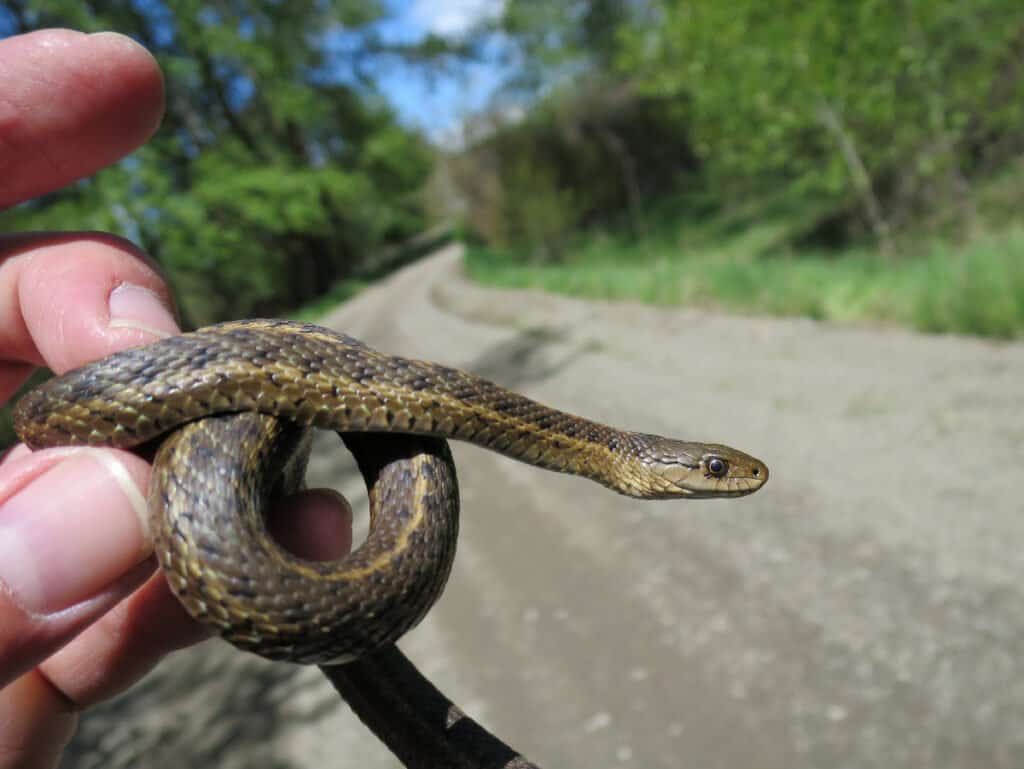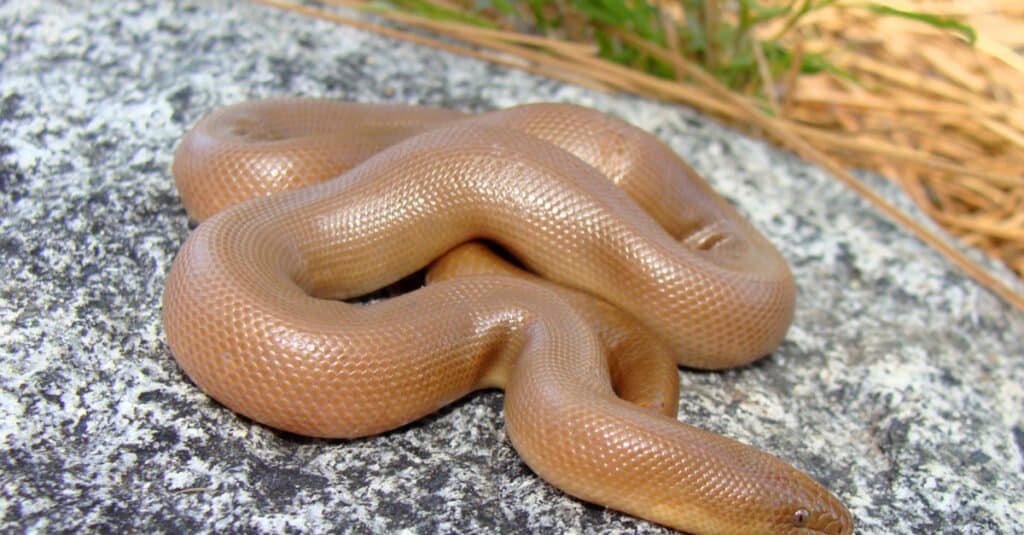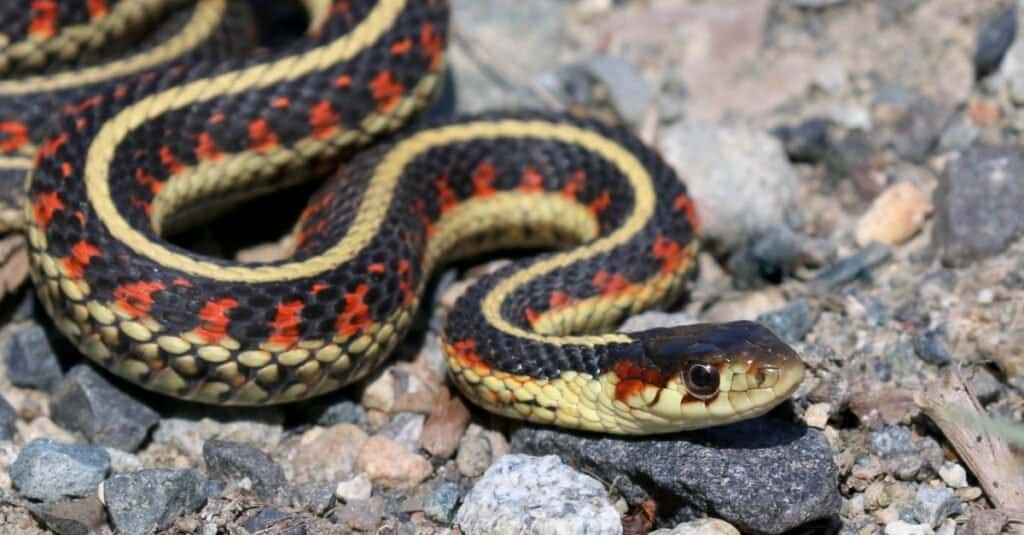Yellowstone National Park is one of the most iconic national parks in the United States. Established in 1872, it is the world’s first national park. But it’s even older than that! According to the National Park Service, Native Americans lived in the Yellowstone National Park region over 11,000 years ago. Yellowstone Park is located in the western part of the country and spreads into three states, the vast majority in the northwest corner of Wyoming. Montana and Idaho have 3% and 1% of the park, respectively.
This famed park is home to a plethora of wildlife, including 5 species of amphibians, 67 species of mammals, 16 species of fish, and 6 species of reptiles. Some of these species are found around the Yellowstone Grand Canyon which is more than 1,000 feet deep, per the US Department of the Interior. Of the 6 confirmed reptile species, 5 are snakes. This article discusses the types of snakes in Yellowstone National Park.
What Types of Snakes Live in Yellowstone National Park?
There are five confirmed snake species in Yellowstone National Park: the bull snake, prairie rattlesnake, rubber boa, common garter snake, and terrestrial garter snake. Of the five, two are constrictors, and three are venomous. However, two of the three are only mildly venomous and are consequently harmless to humans. Meet the 5 snakes of the Yellowstone National Park.
Bull Snake

When threatened, the Bullsnake rears up in an S-shape, hisses and vibrates its tail to mimic the venomous
rattlesnake
.
©Markparker1983/Shutterstock.com
Bull snakes are North-American colubrids known for their lengthy forms. They are one of the longest snakes on the continent and grow to lengths of 48 to 72 inches (4 to 6 feet) on average. It’s no surprise that these reptiles are constrictors. They weigh about 35.2 – 52.8 ounces (2.2–3.3 pounds) but can get as heavy as 158.4 ounces (9.9 pounds).
Bull snakes come in many colors and can be yellow, white, brown, and even albino. They have black, red, or brown blotches that mark their back and sides. However, their bellies are yellow with black spots.
When bull snakes are cornered or feel threatened, they coil up and vibrate their tails like rattlesnakes while hissing. Bull snakes bite but usually only do this when they are picked up or threatened. They don’t have fangs but have short, sharp teeth that can cause painful bites but are unlikely to cause permanent damage.
Prairie Rattlesnake

The prairie rattlesnake can be identified by its light brown skin with dark brown blotches.
©Max Allen/Shutterstock.com
Prairie rattlesnakes are venomous pit vipers found in many northwestern states. Like all pit vipers, these snakes have heat-sensing pits and have an added ability to sense the slightest movements. This makes them incredible hunters that have little reliance on their sight.
These snakes can be identified by their light brown skin with dark brown blotches — and by the rattle at the end of their tail. They grow to average lengths of 3.3 feet and often have a dark stripe behind their eyes.
Prairie rattlesnake venom is primarily hemotoxic, which damaged red blood cells, internal organs, and causes a lot of pain. However, despite their toxic venom, these snakes prefer to stay hidden and are almost reluctant to strike.
Terrestrial Garter Snake

Most western terrestrial garter snakes inhabit damp locations such as marshes, lakes, and streams.
©Randy Bjorklund/Shutterstock.com
Terrestrial garter snakes are quite difficult to identify due to how variable they can be. They mostly have orange, white, or yellow dorsal stripes paired with a single stripe of the same color on each side, making them easy to mix up with other snake species. There are about five subspecies of terrestrial garter snakes that measure anywhere from 18 to 41 inches.
These snakes have mildly venomous saliva, but like all garter snakes, their venom is harmless to humans and more effective on their prey. Most western terrestrial garter snakes inhabit damp locations such as marshes, lakes, and streams, but few others live farther away. Their habitat largely dictates their diet. The more terrestrial-inclined snakes hunt lizards, slugs, and salamanders, while the subspecies closer to water feed on frogs, leeches, tadpoles, and of course, fish.
Rubber Boa

Rubber boas come in brown, olive-green, yellow, and orange variants.
©Matt Jeppson/Shutterstock.com
Rubber boas are small constrictors that measure 1.25 to 2.76 ft on average. These snakes are often used to help people overcome their fear of snakes because they are small and docile. Rubber boas are unlikely to bite and have skin that feels soft and rubbery. They come in brown, olive-green, yellow, and orange variants. However, when they are born, they are pinkish and slightly transparent.
When threatened, these snakes curl into a ball and use their tails to mimic their heads. While this does a lot to confuse and intrigue, it isn’t very effective due to their small sizes. Some other tactics these snakes use to keep prey away include hiding and musking. These snakes aren’t known to bite but will spray musk if they feel threatened. Their nocturnal behaviors make them hard to spot and play a role in keeping them out of predators’ sight.
Common Garter Snake

Garter snakes make great pets.
©iStock.com/randimal
Common garter snakes are medium-length snakes that grow to an average of 4 feet. They come in many colors: yellow, red, gold, orange, brown, black, and even blue. These snakes are commonly spotted in coniferous forests, valleys, forest edges, and meadows. They feed on slugs, frogs, toads, salamanders, and lizards.
Common garter snakes have mild venomous saliva that is more toxic to their prey and only causes slight irritation to humans. Luckily, garter snakes do not bite as often as they spray musk to keep attackers away. They are non-aggressive and can make great pets if purchased from a breeder. They adjust well to handling and are low-maintenance, especially for beginners.
What is Yellowstone’s Sixth Reptile?

The Sagebrush Lizard is the only lizard species in Yellowstone National Park.
©Tyler Hulett/Shutterstock.com
The Sagebrush lizard is the sixth reptile found in Yellowstone National Park. According to the NPS, it is the only confirmed lizard species in the park.
If you’re visiting Yellowstone, remember to treat nature with the respect it deserves. Do not get too close to a snake if you come across one. Most snakes would rather not cross paths with you and are happy to leave you alone if you return the favor. However, if you get bitten by a snake, getting to a park official should be your priority. Luckily, there have only been two recorded snake bites in Yellowstone.
Up Next
The 8 Best Waterfalls in Yellowstone National Park
The 7 Largest Animals in Yellowstone National Park
Are Dogs Allowed in Yellowstone National Park?
The photo featured at the top of this post is © DMartin09/Shutterstock.com
Discover the "Monster" Snake 5X Bigger than an Anaconda
Every day A-Z Animals sends out some of the most incredible facts in the world from our free newsletter. Want to discover the 10 most beautiful snakes in the world, a "snake island" where you're never more than 3 feet from danger, or a "monster" snake 5X larger than an anaconda? Then sign up right now and you'll start receiving our daily newsletter absolutely free.
Thank you for reading! Have some feedback for us? Contact the AZ Animals editorial team.






